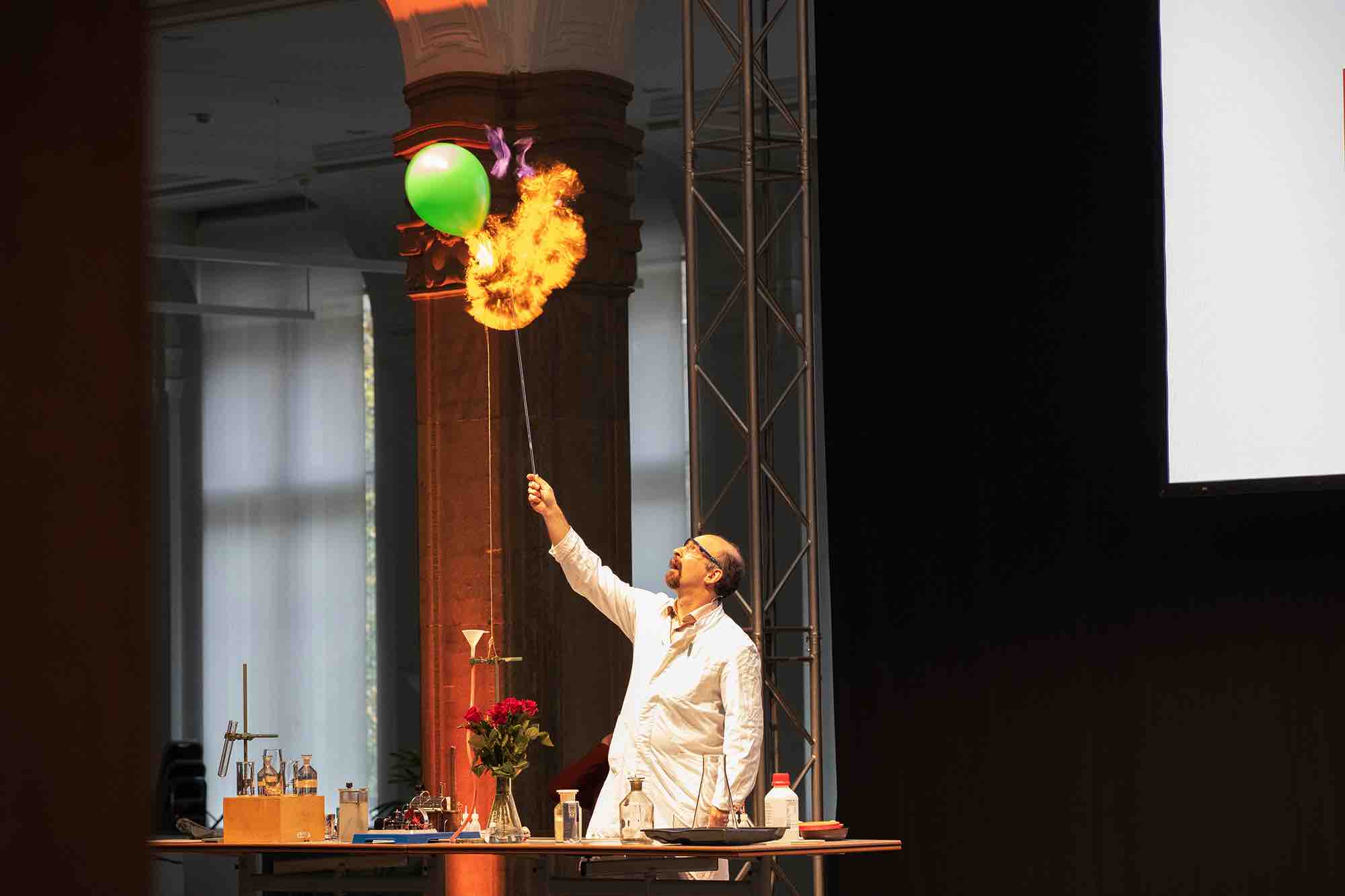
© Jens Lehmkühler / Universität Bremen
CAMPUS CITY: Explosive Start at Am Brill
University of Bremen physics and chemistry show amazes big and small in the old Sparkasse bank building
To mark its 50th birthday, the University of Bremen is presenting itself at numerous events in Bremen’s city center until October 30. The successful first event was a science show with a bang on Saturday afternoon. In the impressive banking hall in the old Sparkasse bank at the Am Brill crossing, university researchers made cans explode and cola fountains shoot into the air. The enthralled audience obviously received a scientific explanation for every live experiment.
Stephan Leupold carefully places an empty drinks can on his laboratory bench and fills it with gaseous hydrogen. The can is open at the bottom and has a small hole in its lid. Then the chemist from the University of Bremen holds a small flame to the hole, which immediately ignites and peacefully burns like a candle. “You should cover your ears. It might get very loud soon,” says the chemist and puts on earmuffs. After a few seconds of tense silence, the can begins to emit a whistling sound and then flies into the air with a loud bang.

© Jens Lehmkühler / Universität Bremen
After a short moment of shock, the audience, which is made up of around 80 children and adults, breaks into enthusiastic clapping. Stephan Leupold subsequently explains what actually just happened. “The hydrogen escaped through this hole at the top and burnt. Air and therefore oxygen was sucked into the can from the bottom. This slowly caused the mixture ratio of hydrogen and air to change in the can. When the mixture is made up of 75 percent hydrogen, the whole things becomes explosive. Detonating gas forms and causes a bang.”
The deafening demonstration with the detonating gas reaction was only one of many live experiments with which the show trio from the University of Bremen provided entertainment in the expressionist banking hall of the listed Sparkasse bank building at the Am Brill crossing. Dr. Stephan Leupold from Faculty 02: Biology / Chemistry and Professor and Justus Notholt from Faculty 01: Physics / Electrical Engineering alternated and carried out chemistry and physics experiments respectively. Matthias Buschmann from Faculty 01, who made sure that all equipment and materials were ready on the stage and backstage, helped them.

© Jens Lehmkühler / Universität Bremen
As should be the case at any university event, the experiments were not an end to themselves but rather had the purpose of passing on knowledge. In order to show the enormous power of pressure differences, Justus Notholt sucked the air out of a long plastic tube with a vacuum pump and then used the vacuum canon to shoot a table tennis ball into a cardboard box. The light ball developed such momentum that it traveled through the cardboard and landed in the box with a thud.
Stephan Leupold showed the big and small candy fans in the audience how much energy a gummy bear holds. He melted potassium chlorate - a white salt - in a test tube using a Bunsen burner. He then threw a gummy bear into the tube, which started to burn brightly like a magnesium flare.

© Jens Lehmkühler / Universität Bremen
During the rest of the show, some of the things that the audience learnt were how to create “elephant tooth paste” using hydrogen peroxide, what a table tennis ball dancing above a hairdryer has to do with Bernoulli’s principle, and how it is possible to hammer in a nail using a shock-frosted banana thanks to liquid nitrogen.
The end was fizzy. Together, the trio covered the stage with a large tarpaulin. Then the legendary classics among science experiments was carried out - the cola and Mentos fountain. The scientists put the peppermint sweets into a full bottle of cola light. Immediately, countless carbon dioxide bubbles formed on the finely porous surface of the candy, which then floated to the top and together with the substances in cola and candy cause excessive foam to form. A meter-high fountain of cola exploded into the air in the old Sparkasse banking hall like a geyser. The trio promised the responsible janitor, who was sat in the last row in the audience, that they would clean everything away later. He accepted their promise and clapped together with the big and small show guests.
Further information
Further information on CAMPUS CITY and the diverse program can be found here: CAMPUS CITY.
A great deal of information surrounding 50 years of the University of Bremen can be found on the website www.uni-bremen.de.